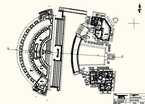Amphitheatre in Royal Łazienki
Jan Chrystian Kamsetzer
alias Teatr na Wodzie (Theatre on Water), Teatr na Wyspie (Theatre on the Isle)Agrykoli 1 | |
| show on the map | http://www.lazienki-krolewskie.pl/ |
Important events
People
History
In the poetic stage directions for Noc listopadowa (November Night) (1904) [1] Stanisław Wyspiański wrote:
‘In Stanislavian Park, upon an isle
His Majesty’s theatre rests.
There is an upraised stage across the water
facing the semicircle for the guests.
Up on the stony crown, upon their thrones
tragedians famous in stone silence sit.
Watching how fare on this stage of today
the pieces they had writ.’
The Amphitheatre on the Island, by the southern pond in Łazienki, designed by Jan Chrystian Kamsetzer, was erected on the site of an earlier wooden construction between 1790 and 1791. The auditorium, holding 1,000 people, is separated from the stage situated on the island by a canal. It consists of stalls with the royal box located by the water, and a semicircular amphitheatre rising up on stone steps with seats for spectators. Sixteen statues of famous playwrights (designed by André Lebrun and sculpted by Tommaso Righi) were placed along the upper edge of the amphitheatre. These were the statues of Aeschylus, Sophocles, Euripides, Aristophanes, Menander, Plautus, Terence, Seneca, Shakespeare, Racine, Molière, Metastasio and Lessing, as well as Stanisław Trembecki and Julian Ursyn Niemcewicz. On the stage there are permanent sets, made of stone, depicting ancient ruins, with Corinthian columns and statues. The infrastructure is hidden behind trees, used as natural wings. The ceremonial inaugural performance, on 7 September 1791, was the ballet Cleopatra by Renault. The amphitheatre was used as a royal stage only for five years, until the partitions of Poland. Then, in 1817, it passed into the hands of the Russian tsar along with Łazienki. From 1822 onwards, public theatre performances were held here in summer, though these grew less and less frequent over time. Between 1920 and 1927 the precious building was renovated, and the badly damaged statues of playwrights were removed to be replaced with copies of eight of them. The Amphitheatre on the Island is one of the most interesting examples of 18th century theatre architecture anywhere in the world.[2]
[1] Stanisław Wyspiański, Noc listopadowa, [in:] Dzieła zebrane, Kraków 1959, vol. 8, p. 173.
[2] Barbara Król-Kaczorowska, Teatry Warszawy..., op. cit.
Literature:
-
Beyond Everydayness. Theatre Arhcitecture in Central Europe, red. Igor Kovacevic, National Theatre in Prague, Praga 2010.
-
Król-Kaczorowska B., Teatr Dawnej Polski. Budynki, dekoracje, kostiumy, Warszawa 1971.
-
Król-Kaczorowska B., Teatry Warszawy, Warszawa 1986.
-
Król-Kaczorowska B., Teatry na wolnym powietrzu w Polsce XVIII wieku. Teatry prowizoryczne. Teatry stałe. Teatry „zielone”, „Pamiętnik Teatralny” 1955 No. 2, pp. 69–100.
-
Król-Kaczorowska B., Z teatru na Zamku Królewskim do Łazienek? Jeszcze o teatrach Stanisława Augusta, „Pamiętnik Teatralny” 1974 No. 3–4, pp. 355–370.
-
Tatarkiewicz W., Łazienki Warszawskie, Warszawa 1975.
Author: Jarosław Komorowski
Jarosław Komorowski:
Royal Theatre in the Old Orangery, Theatre on Krasiński Square, Theatre in the Castle Museum, Opernhaus, Amphitheatre in Royal Łazienki, Theatre Room in the Castle of Wacław Rzewuski, Theatre of Antoni Sułkowski, Theatr of Sapieha in Różana, Fencing School, Collegium Nobilium Theatre, Theatre building near Hetman Jan Branicki’s palaceAdditional information
No information has yet been entered
Add information



















